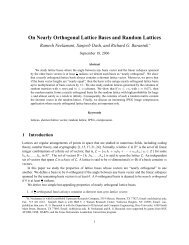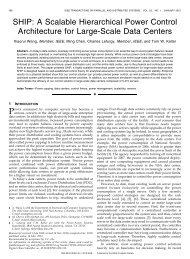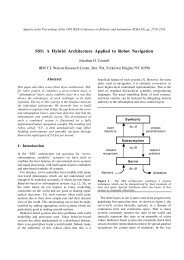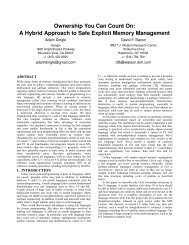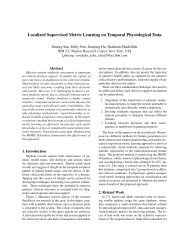Design and Implementation of a Homomorphic ... - Researcher
Design and Implementation of a Homomorphic ... - Researcher
Design and Implementation of a Homomorphic ... - Researcher
You also want an ePaper? Increase the reach of your titles
YUMPU automatically turns print PDFs into web optimized ePapers that Google loves.
H/2m each <strong>and</strong> 0 with probability 1 − H/m. Let f(X) = ∑ m−1<br />
i=0 f iX i . Then for fixed r <strong>and</strong><br />
H, m → ∞, we have<br />
E[|f(τ)| 2r ] ∼ r!H r .<br />
In particular, for H ≥ 2r 2 , we have<br />
E[|f(τ)| 2r ]<br />
∣ r!H r − 1<br />
∣ ≤ 2r2<br />
H + 2r+1 r 2<br />
m .<br />
Before proving Theorem 1, we introduce some notation <strong>and</strong> prove some technical results that<br />
will be useful.<br />
Recall the “falling factorial” notation: for integers n, k with 0 ≤ k ≤ n, we define n k =<br />
∏ k−1<br />
j=0<br />
(n − j).<br />
Lemma 1. For n ≥ k 2 > 0, we have n k − n k ≤ k 2 n k−1 .<br />
Pro<strong>of</strong>. We have<br />
n k ≥ (n − k) k = n k −<br />
( ( ( k k k<br />
kn<br />
1)<br />
k−1 + k<br />
2)<br />
2 n k−2 − k<br />
3)<br />
3 n k−3 + − · · · .<br />
The lemma follows by verifying that when n ≥ k 2 , in the above binomial expansion, the sum <strong>of</strong><br />
every consecutive positive/negative pair <strong>of</strong> terms in non-negative.<br />
Lemma 2. For n ≥ 2k 2 > 0, we have n k ≤ 2n k .<br />
Pro<strong>of</strong>. This follows immediately from the previous lemma.<br />
Next, we recall the notion <strong>of</strong> the Stirling number <strong>of</strong> the second kind, which is the number <strong>of</strong><br />
ways to partition a set <strong>of</strong> l objects into k non-empty subsets, <strong>and</strong> is denoted { l<br />
k}<br />
. We use the<br />
following st<strong>and</strong>ard result:<br />
l∑<br />
{ l<br />
n<br />
k}<br />
k = n l . (1)<br />
k=1<br />
Finally, we define M 2n to be the number <strong>of</strong> perfect matchings in the complete graph on 2n<br />
vertices, <strong>and</strong> M n,n to be the number <strong>of</strong> perfect matchings on the complete bipartite graph on two<br />
sets <strong>of</strong> n vertices. The following facts are easy to establish:<br />
<strong>and</strong><br />
M n,n = n! (2)<br />
M 2n ≤ 2 n n!. (3)<br />
We now turn to the pro<strong>of</strong> <strong>of</strong> the theorem. We have<br />
f(τ) 2r = f(τ) r f(¯τ) r =<br />
∑<br />
f i1 · · · f i2r · τ i1 · · · τ ir · τ −i r+1<br />
· · · τ −i 2r<br />
.<br />
i 1 ,...,i 2r<br />
We will extend the usual notion <strong>of</strong> expected values to complex-valued r<strong>and</strong>om variables: if U <strong>and</strong><br />
V are real-valued r<strong>and</strong>om variables, then E[U + V i] = E[U] + E[V ]i. The usual rules for sums <strong>and</strong><br />
products <strong>of</strong> expectations work equally well. By linearity <strong>of</strong> expectation, we have<br />
E[f(τ) 2r ] =<br />
∑<br />
E[f i1 · · · f i2r ] · τ i1 · · · τ ir · τ −i r+1<br />
· · · τ −i 2r<br />
. (4)<br />
i 1 ,...,i 2r<br />
38




